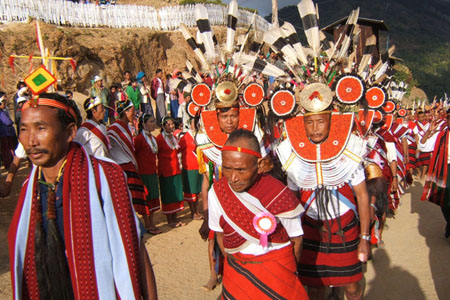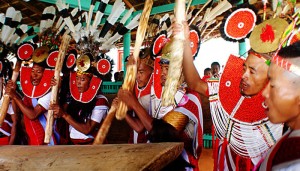Naga is a multi-ethnic minority group that currently resides in northwestern Myanmar and is scattered across India's states, for example, Assam, Nagaland, Manipur, and Arunachal Pradesh.
There are approximately 300.000 Naga people in Myanmar, account for 0.4% of Burmese people which is divided into 64 tribals such as Angami, Ao, Achakesang, Chang, Katcha, Khiamungan and others. Each tribe consists of several clans, mostly in the Chindwin Basin at the foot of Mount Saramati (Chin State, Myanmar).
Naga society is organized as a self-managed village within the framework of federal regulations. Many Naga groups have organized their own army unit to protect the entire community. In each village, a watchtower is built on the trunk of the tree to observe the static in the area.

When the British invaded Burma in the mid-nineteenth century, the Naga was very tenacious struggling against the British colonialists, but the lack of links between the tribes had made them unable to gain autonomy. Only after 17,000 Naga people was put into combat in the First World War in Europe, the solidarity of the Naga is rising, led to the movement for independence of Naga.

Naga people attach special importance to the origin of each member, so each ethnic group has a distinctive customary style and uses the different color, casual dress code in the festival to distinguish. Not only the types of clothing, but they also regulate the hairstyle, conical type, face tattoos, accessories, and others.
In casual life, men frequently take off their shirts to show their wide shoulders and just wear shorts or loincloths. Besides, traditional women's cloth include shirts and skirts (short, long, depending on region). Annually, the Naga New Year Festival taking place in January is a great occasion for tourists in Myanmar tours to get to know more about the Naga people. At the festival, Both men and women get dressed in colorful costumes with impressive hats made from feathers, shells and fish bones, besides, they like wearing necklaces which are made of tiger's bone, bear's nails, which stands for the victory and social position.
The Naga make a living mainly by exploiting forest sources and cultivation. Men join a group of hunting in the jungle, while women do traditional brocade weaving at home. The literacy rate in the Naga community is about 61%.
The traditional costumes of Naga are considered one of the best costumes in the world. Naga men in the festival who usually wear kinds of hats are made from feathers, shells and fish bones.

It's really beautiful to see my Naga people, the Tangkhul tribe in particular as depicted here (based on the costume), in their glorious costume. I, as a Tangkhul Naga am proud to see my brothers growing, struggling relentlessly even in Myanmar. I hope and pray that the present government will usher into a new world of peace and development; and in particular, help all of us Nagas live as one united nation.